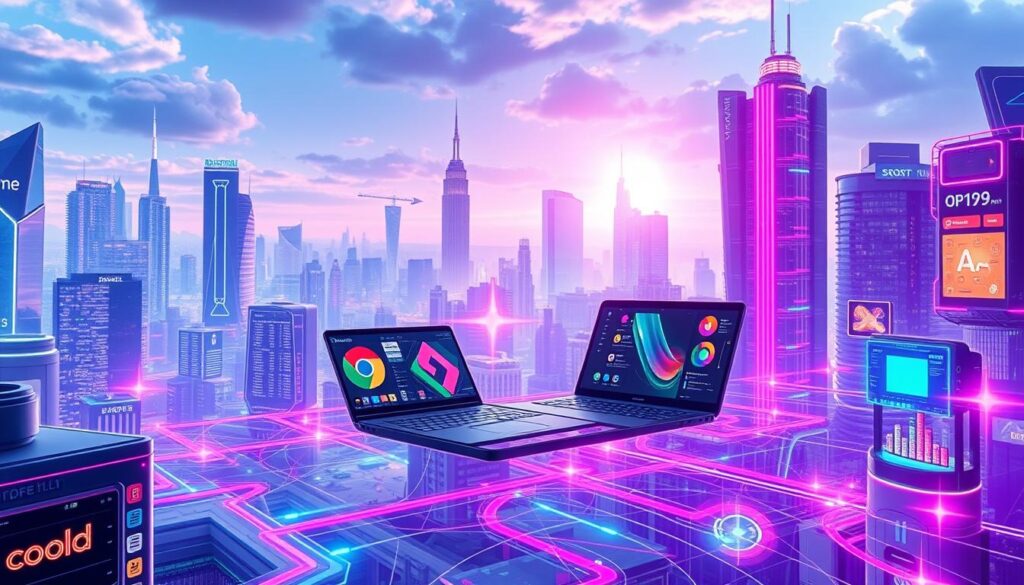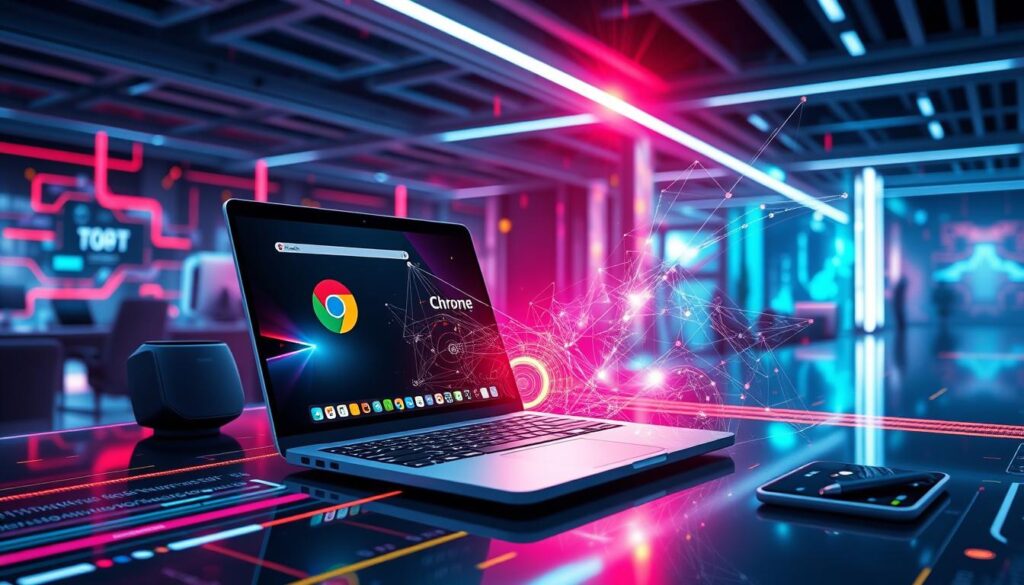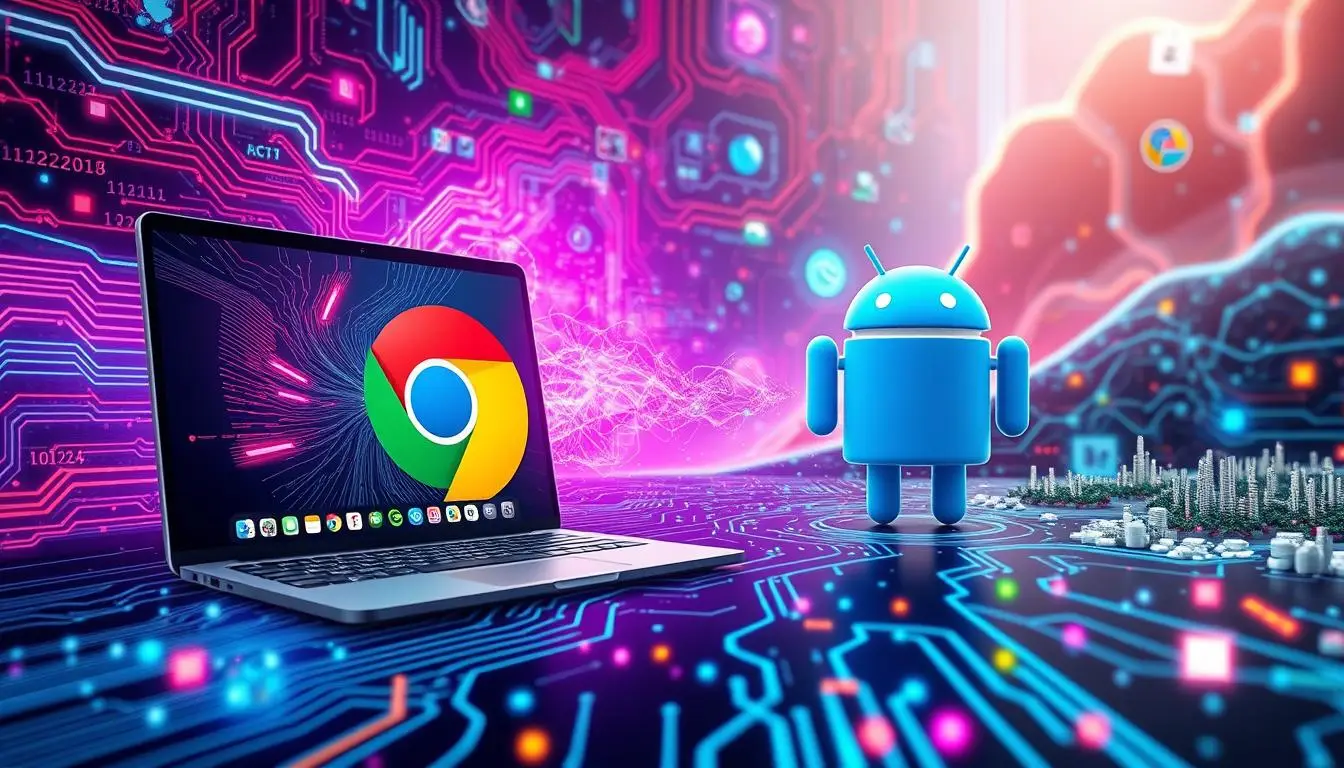Google is making big changes to Chrome OS. They’re planning to merge Chrome OS with Android. This move will make Google’s operating systems stronger and more unified. By using the Android Bluetooth stack, known as “Fluoride,” Chrome OS will work better with Android.
This change means that apps will run more smoothly across different devices and Chromebooks. Google promises that Chrome OS will still be secure, reliable, and easy to manage. However, we’re going to see some exciting changes. The desktop experience will improve, offering better support for windows, devices, and various inputs.
Key Takeaways
- Chrome OS is evolving, leveraging Android’s Fluoride Bluetooth stack for improved performance
- Project Floss initiatives aim to elevate the Bluetooth ecosystem’s value and usability across platforms
- Chromebooks offer diverse functionalities, supporting Linux, Web, and Android apps
- The shift in Chrome OS entails considerations for app availability and software alternatives
- Future Chromebooks may offer Android OS experiences, expanding the range of accessible apps
- Google is poised to enhance its operating systems, potentially altering current devices and user experiences
The Announcement: Chrome OS Embracing Android’s Framework
Google announced a major update: Chrome OS will now use Android’s Linux kernel and frameworks. This move aims to make apps work better between Chrome OS and Android. It means a smoother experience for users. The change was officially made public on June 12, 2024.
Google wants to push forward with AI and make engineering simpler. With nearly two hundred thousand employees, Google plans to change how we use Chrome and Android devices. This will keep Google ahead by making devices work better together, from phones to XR glasses.
The shift to Android’s framework is more than a tech update; it’s strategic. Google hopes to make apps work better together and bring new benefits to Chrome OS on Android. Users can look forward to new features faster and easier development.
- Future Chromebooks will run on Android OS, bringing together app support and updates.
- A new Chrome version for Android will support extensions, improving functionality.
- Chrome OS will now use Android’s Bluetooth, allowing connection to more devices.
Google is focusing on making Chrome OS more Android-like, not just for now, but for the future. Google promises that “Chromebooks will get updates every four weeks, staying competitive.”
This merger means operating systems can share features more quickly, cutting down on extra work. It’s good news for both developers and users, highlighting better performance, reliability, and app compatibility.
“This is an exciting evolution for Chrome OS and Android,” says Google. They believe this merge is key to improving how operating systems meet user needs and satisfaction.
As Android and Chrome OS combine, we’re entering a new phase of integrated tech. This move signals a future filled with efficiency and innovation.
Chrome OS Migrating to Android: Behind Google’s Strategic Move
Google is changing things up to compete with the iPad. By optimizing Chrome OS for Android integration, they’re taking a big step. This move helps them use the best of both systems. The goal? To create a stronger, unified operating system.

The merger of future of Chrome OS and Android looks to mix Chrome OS’s easy-to-use features with Android’s wide app choices. This combination should make things better for users, especially for those using high-end tablets. It could help Google stand up to Apple.
Google’s adoption of the Android Linux kernel in Chrome OS is a clear indicator of their long-term vision for a seamless, integrated user experience across all devices.
Also, Google wants to make its work simpler. In the past, having two systems, Chrome OS and Android, split their focus. By optimizing Chrome OS for Android integration, they’re bringing their projects together. This should lead to quicker updates and new features.
- Integration improves app compatibility across different devices.
- A simpler development process means less bugs and better performance.
- Google’s plan supports cross-platform use, aiming to do better than Microsoft’s Windows platforms.
At Google’s I/O conference, the feedback will shine a light on what’s next for future of Chrome OS and Android. This step forward will change how we use our gadgets. It opens up new chances for developers and users alike.
Anticipating Changes: The Future Chrome OS User Experience
The journey of Chrome OS’s evolution has some big milestones. The chrome os and android convergence is perhaps the most transformative. Looking forward, integrating Android apps into Chrome OS means more than a technical update. It starts a new era where things are easier to use and more flexible.

In future updates, expect to see Chrome OS and Android merge smoothly. With the introduction of Lacros in ChromeOS 116, things are changing. This marks a big shift in how web browsing is handled. Lacros and the native Chrome browser will work together before Lacros takes the lead by 2024.
This slow and careful update strategy ensures that everything works well for all users. It’s part of Google’s plan to make sure improvements are stable and effective.
- Unified App Ecosystem: Android apps on Chrome OS will let users have more apps. This closes the gap between mobile and laptop use.
- Enhanced Versatility: Future Chrome OS versions will offer a touch-friendly interface. This is perfect for convertibles and detachables, offering a tablet feel but with laptop power.
- Incremental Updates: The careful release of Lacros shows how Google values a smooth experience. It’s like other seamless updates they’ve done.
The Chrome side panel’s new ‘Read Anywhere’ feature also shows commitment to better in-browser tools. It replaces the old Reader Mode with something stronger and more user-friendly. This is part of a wider push to make sure updates improve things in ways that users really want.
The unfoldment of chrome os and android convergence shows Google’s focus on details. They’re expanding android apps on Chrome OS and fixing hardware issues, like with the camera in recent updates. This dual focus on hardware and software ensures Chrome OS is moving towards being more integrated and focused on the user.
The changes in operating systems are exciting for Chrome OS users. The merging with Android boosts what you can do. It also changes the game for what’s expected in a system that moves smoothly between work, learning, and play.
The Implications for Current Chrome OS and Android Users
The merging of chrome os and android is a big deal for everyone using these systems. This blend means users get a smoother flow between services and apps. Chrome OS has been preparing for this by adding Android-like features.
Updates like Android 12L and Android 13 are making the merge obvious. They bring a taskbar that looks like Chrome OS’s to Android. This means Android tablet users will get a Chromebook-like experience. They will enjoy features like changing profiles easily and using two apps at once more smoothly.
Switching between Android and Chrome OS devices will feel seamless. Users will notice increased productivity. Thanks to Chrome OS’s fast start-up and long battery life, Android devices will also become quicker and last longer. This change is exciting for everyone.
For app developers, the benefits are huge. They’ll have more apps to work with from both Chrome OS and Android. Even though Chrome Web Store has fewer apps, Android’s wide array fills that gap. This means more choices and better tools for users.
People who use Google’s tools for work will find things easier. The merge brings new chances to be more efficient. Google is aiming to make technology work better for companies and schools. They want Chromebooks to be a top choice for secure computing. This could lead to a future where any app works on any device, making technology simpler for everyone.

